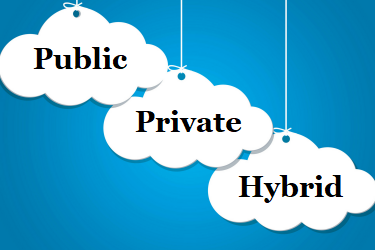July 17, 2018 by Siobhan Climer
This blog is Part 3 of a three-part guide to cloud storage. In Part 1, we examined the basics of cloud computing. In Part 2, we discussed the different types of cloud storage. In this final section, we will examine how you can leverage the cloud for business strategy.
Part 1: What is cloud storage?
Part 2: Types of cloud storage
Part 3: Leverage the cloud for business
Today, we’ll be exploring the following questions:
- How can you protect your data?
- What does a cloud migration strategy look like?
- How can you leverage the cloud for business strategy?
- What is the right cloud solution for you?
How Can You Protect Your Data?
 Recently, we wrote about the phenomenon of mattress money – people storing money under their mattress (or in various other residential locations) as a form of protection. We found that for similar reasons, lots of businesses are hesitant to move their data off premise and into online storage because it seems easier to protect your data when it’s on-site. But control doesn’t equal security.
Recently, we wrote about the phenomenon of mattress money – people storing money under their mattress (or in various other residential locations) as a form of protection. We found that for similar reasons, lots of businesses are hesitant to move their data off premise and into online storage because it seems easier to protect your data when it’s on-site. But control doesn’t equal security.
So how can you protect your data in the cloud?
One common way companies solve for this is to employ a hybrid cloud solution model, whereby sensitive data is maintained on-site while the cloud stores emails and other less-critical information and applications. Your most valuable data won’t be at risk. And hybrid models work great if you’re trying to leverage the cloud for business.
However, the truth is that over half of all data breaches come from human error – bad passwords, unsecured Wi-Fi connections, and broad access privileges. These habits will leave your data vulnerable whether it’s in the cloud or on-premise.
The key is to educate and train your employees in proper password maintenance and security, encrypt your files, and use encrypted cloud solutions. The benefit of this is that these habits will translate to other forms of data security, improving the processes you already have in place.
One final note: read the terms and agreements when engaging with a cloud provider. Cloud security is a shared responsibility. Know precisely what your responsibility is and create a plan for implementation and monitoring.
What Does A Cloud Migration Strategy Look Like?
 As much as we may sometimes wish it, there is no one-size-fits-all cloud migration strategy. If you want to leverage the cloud for business, you need to do the hardest thing first: plan. Adequate preparation is the most necessary – and the most missed – step in deploying cloud solutions.
As much as we may sometimes wish it, there is no one-size-fits-all cloud migration strategy. If you want to leverage the cloud for business, you need to do the hardest thing first: plan. Adequate preparation is the most necessary – and the most missed – step in deploying cloud solutions.
Migrating to the cloud isn’t about making one giant leap. Instead, by following a cloud deployment roadmap, you take precise, directed steps toward your goals. Your team will need to determine a cloud deployment model (public, private, or hybrid) and perform an application dependency assessment. This may involve researching and identifying software-as-a-service (SaaS) applications that can replace existing on-premise software. These SaaS applications are tailored to work with specific cloud solutions, and they offer a smooth cloud migration transition.
You’ll need to coordinate your migration schedule with your existing hardware solutions. Consider the lifecycle of your hardware so you ensure you gain its full value. This can help ease the transition as well, assuming your hardware does not come end-of-life all at once.
Instead of devoting your IT team to the minutiae analysis and research involved in this analysis, consider bringing in a managed IT services team that can offload these tasks.
How Can You Leverage The Cloud For Business Strategy?
One of the biggest benefits of the cloud is its scalability and price model. Unlike the high fixed-price costs of a private data center, the cloud’s pay-as-you-go model allows executive teams to develop a more aggressive strategy that can contract and expand as the market changes. This directly relates to scalability, since strategy directly relates to growth and cost. Markets change and business leaders may make the wrong investment; the cloud model abates this risk somewhat, putting leadership teams in a position to scale back if necessary.
Strategy isn’t relegated to the C-suite alone, though; utilizing cloud solutions puts the IT team in a position to invest and develop more strategically sound practices. The best way to leverage the cloud for business is to consider what resources it makes available: time, space, and creative opportunity. This translates to greater agility within the team and for its leaders, increasing opportunities to respond to – and perhaps lead – industry movements.
What Is The Right Cloud Solution For You?
 Public? Private? Hybrid? You’ll need to choose a cloud deployment model that fits you right now, because what works today might not always work. And that’s okay. You may start in a hybrid on-premise, private cloud model and eventually move to a full private cloud. Or perhaps you use multiple public clouds to house different types of data based on SaaS applications. Choosing the right path doesn’t have to be a shot in the dark, though. By analyzing where you are and where you want to go, you can develop a cloud computing roadmap that helps you reach your business goals.
Public? Private? Hybrid? You’ll need to choose a cloud deployment model that fits you right now, because what works today might not always work. And that’s okay. You may start in a hybrid on-premise, private cloud model and eventually move to a full private cloud. Or perhaps you use multiple public clouds to house different types of data based on SaaS applications. Choosing the right path doesn’t have to be a shot in the dark, though. By analyzing where you are and where you want to go, you can develop a cloud computing roadmap that helps you reach your business goals.
The Cloud Is Complex: A Review
 The term “cloud” evokes a lazy, hazy feeling, but the cloud is anything but. Let’s briefly summarize what we have reviewed throughout our series.
The term “cloud” evokes a lazy, hazy feeling, but the cloud is anything but. Let’s briefly summarize what we have reviewed throughout our series.
Cloud storage is the process of storing digital data in an online space that spans multiple servers and locations, and it is usually maintained by a hosting company. That data is stored physically somewhere, though you might not ever know the precise location. The benefits are enormous; the cloud offers a competitive advantage, increased data retrieval, improved collaboration tech, efficient pay models, environmentally-friendly business solutions, and increased capabilities. However, increased attack surface areas, supplier reliance, and concerns over security remain prevalent.
The types of cloud storage are numerous. Cloud Storage Architecture refers to the relationship between the components needed to form a cloud computing network. There is the primary variability in cloud storage architecture that translates to different deployment models: public, private, and hybrid. That data is then stored in different ways within these different models, through file, block, or object storage.
To best leverage the cloud for business strategy, executive teams need to examine a path to the cloud and develop a Cloud Technology Roadmap that plots a map to guide the business from where they are to where they want to go.
Contact us today to schedule a roadmap that will help migrate your business to the cloud.
Like what you read?
About Mindsight
Mindsight, a Chicago IT services provider, is an extension of your team. Our culture is built on transparency and trust, and our team is made up of extraordinary people – the kinds of people you would hire. We have one of the largest expert-level engineering teams delivering the full spectrum of IT services and solutions, from cloud to infrastructure, collaboration to contact center. Our highly-certified engineers and process-oriented excellence have certainly been key to our success. But what really sets us apart is our straightforward and honest approach to every conversation, whether it is for an emerging business or global enterprise. Our customers rely on our thought leadership, responsiveness, and dedication to solving their toughest technology challenges.
Contact us at GoMindsight.com.
About The Author
Siobhan Climer, Science and Technology Writer for Mindsight, writes about technology trends in education, healthcare, and business. She previously taught STEM programs in elementary classrooms and museums, and writes extensively about cybersecurity, disaster recovery, cloud services, backups, data storage, network infrastructure, and the contact center. When she’s not writing tech, she’s writing fantasy, gardening, and exploring the world with her twin two-year old daughters. Find her on twitter @techtalksio.
Clutch.co Names Mindsight a Leader in Cloud Computing Consulting




